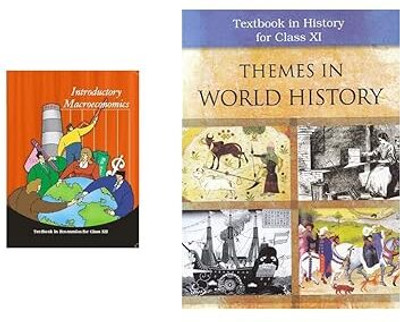ORIGINAL NCERT Introductory Macroeconomics - Textbook In Economics For Class - 12 - 12105 & Themes In World History For Class - 11 - 11090 (Set Of 2 Books) Latest Edition 2025-2026 (Pack Of 2 Book's)(Paperback, NCERT)
Quick Overview
Product Price Comparison
Introductory Macroeconomics - Textbook in Economics for Class - 12 - 12105 The 2014 edition of Introductory Macroeconomics - Textbook in Economics helps the students of class 12 to study the branches of economics that cover the behaviour and performance of an economy as a whole. It has been published by NCERT and closely maintains parity with the syllabus that has been laid out by the CBSE. The Contents of the Book are as Follows: ŌĆó INTRODUCTION ŌĆó Emergence of Macroeconomics ŌĆó Context of the Present Book of Macroeconomics ŌĆó 2. NATIONAL INCOME ACCOUNTING ŌĆó Some Basic Concepts of Macroeconomics ŌĆó Circular Flow of Income and Methods of Calculating National Income - The Product or Value Added Method - Expenditure Method - Income Method ŌĆó Some Macroeconomic Identities ŌĆó Goods and Prices ŌĆó GDP and Welfare ŌĆó 3. MONEY AND RANKING ŌĆó Functions of Money ŌĆó Demand for Money - The Transaction Motive - The Speculative Motive ŌĆó The Supply of Money - Legal Definitions: Narrow and Broad Money - Money Creation by the Banking System - Instruments of Monetary Policy and the Reserve Bank of India ŌĆó 4. INCOME DETERMINATION ŌĆó Ex-ante and Ex-post ŌĆó Movement Along a Curve versus Shift of a Curve ŌĆó The Short Run Fixed Price Analysis of The Product Market - A Point on the Aggregate Demand Curve - Effects of an Autonomous Change on, Equilibrium Demand in the Product Market - The Multiplier Mechanism ŌĆó 5. THE Government: BUDGET AND THE ECONOMY ŌĆó Components of the Government Budget - The Revenue Account - The Capital Account - Measures of Government Deficit ŌĆó Fiscal Policy - Changes in Government Expenditure - Changes in Taxes - Debt ŌĆó 6. Open ECONOMY macroeconomics ŌĆó The Balance of Payments - BoP Surplus and Deficit ŌĆó The Foreign Exchange Market - Determination of the Exchange Rate - Flexible Exchange Rates - Fixed Exchange Rates - Managed Floating -Exchange Rate Management: The International Experience ŌĆó The Determination of Income in an Open Economy - National Income Identity for an Open Economy - Equilibrium Output and the Trade Balance ŌĆó Trade Deficits, Savings and Investment Salient Features of the Textbook: ŌĆó Helps the students understand and analyse all aggregate indicators and the macroeconomic factors that influence the economy. ŌĆó Helps the students to understand how the government and corporations use macroeconomic models to help in formulating economic policies and strategies. ŌĆó Includes interactive database that is full of graphs and schematic representations of data, which not only makes it easy to grasp the basic concepts but also easy to memorise.Themes in World History for Class - 11 - 11090An answer to the inquisitiveness of its young readers, this Themes in World History textbook remains a favourite amongst the students of Class 11. It has been published by the NCERT and it closely follows the syllabus prescribed by the CBSE. This 2013 edition comes in a paperback form. Chapters covered in this book: ŌĆó Section I: EARLY SOCIETIES ŌĆó Theme I: From the Beginning of Time ŌĆó Theme 2: Writing and City Life ŌĆó Section II: EMPIRES ŌĆó Theme 3: An Empire Across Three Continents ŌĆó Theme 4: The Central Islamic Lands ŌĆó Theme 5: Nomadic Empires ŌĆó Section III: CHANGING TRADITIONS ŌĆó Theme 6: The Three Orders ŌĆó Theme 7: Changing Cultural Traditions ŌĆó Theme 8: Confrontation of Cultures ŌĆó Section IV TOWARDS MODERNISATION ŌĆó Theme 9: The Industrial Revolution ŌĆó Theme 10: Displacing Indigenous Peoples ŌĆó Theme 11: Paths to Modernisation Salient features of this Textbook: ŌĆó It features content that has been written in a simple language which is easy for the students to grasp the basic concepts. ŌĆó The chapters have been divided into sub-subsections which will help the young minds to learn every detail of an era. ŌĆó The interactive language introduces the students to the continental and the world History. ŌĆó It helps the students to learn the emergence of the modern society. ŌĆó Exercises at the end of each chapter help the student to evaluate their own knowledge base.

